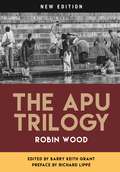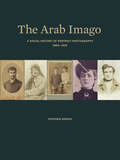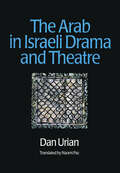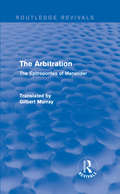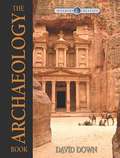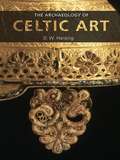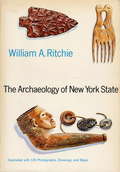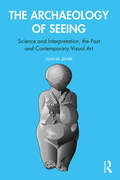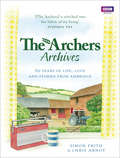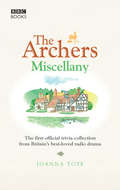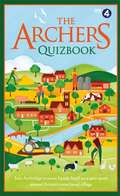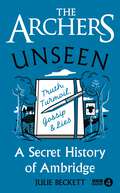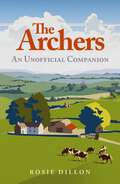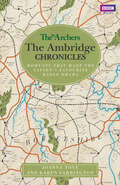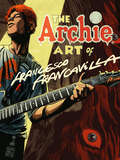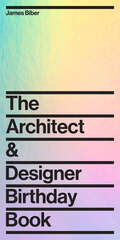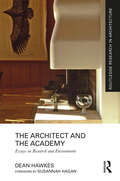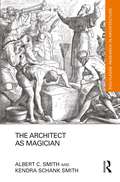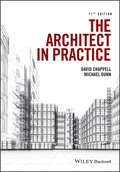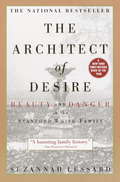- Table View
- List View
The Apse Mosaic in Early Medieval Rome: Time, Network, and Repetition.
by Thunø. ErikThis book focuses on apse mosaics in Rome, which were commissioned by a series of popes between the sixth and ninth centuries CE. Through a synchronic approach that challenges current conceptions about how works of art interact with historical time, Erik Thunø proposes that the apse mosaics produce an inter-visual network that collapses their chronological succession in time into a continuous present in which the faithful join the saints in the one living body of the Church of Rome. Throughout, this book situates the apse mosaics within the broader context of viewership, the cult of relics, epigraphic tradition, and church ritual while engaging topics concerned with intercession, materiality, repetition and vision.
The Apu Trilogy: New Edition (Contemporary Approaches to Film and Media Series)
by Robin WoodThe Apu Trilogy is the fifth book written by influential film critic Robin Wood and republished for a contemporary audience. Focusing on the famed trilogy from Indian director Satyajit Ray, Wood persuasively demonstrates his ability at detailed textual analysis, providing an impressively sustained reading that elucidates the complex view of life in the trilogy. Wood was one of our most insightful and committed film critics, championing films that explore the human condition. His analysis of The Apu Trilogy reveals and illuminates the films' profoundly humanistic qualities with clarity and rigor, plumbing the psychological and emotional resonances that arise from Ray's delicate balance of performance, camerawork, and visual design. Wood was the first English-language critic to write substantively about Ray's films, which made the original publication of his monograph on The Apu Trilogy unprecedented as well as impressive. Of late there has been a renewed interest in North America in the work of Satyajit Ray, yet no other critic has come close to equaling the scope and depth of his analysis. In his introduction, originally published in 1971, Wood says reactions to Ray's work were met with indifference. In response, he offers possible reasons why this occurred, including social and cultural differences and the films' slow pacing, which contemporary critics tended to associate with classical cinema. Wood notes Ray's admiration for Western film culture, including the Hollywood cinema and European directors, particularly Jean Renoir and his realist films. Assigning a chapter to each Pather Panchali (1955), Aparajito, (1957), and The World of Apu, (1959), Wood goes on to explore each film more thoroughly. One of the aspects of this book that is particularly rewarding is Wood's analytical approach to the trilogy as a whole, as well as detailed attention given to each of the three films. The book, with a new preface by Richard Lippe and foreword by Barry Keith Grant, functions as a master class on what constitutes an in-depth reading of a work and the use of critical tools that are relevant to such a task. Robin Wood's The Apu Trilogy offers an excellent account of evaluative criticism that will appeal to film scholars and students alike.
The Arab Imago: A Social History of Portrait Photography, 1860–1910
by Stephen SheehiThe first history of indigenous photography in the Middle EastThe birth of photography coincided with the expansion of European imperialism in the Middle East, and some of the medium's earliest images are Orientalist pictures taken by Europeans in such places as Cairo and Jerusalem—photographs that have long shaped and distorted the Western visual imagination of the region. But the Middle East had many of its own photographers, collectors, and patrons. In this book, Stephen Sheehi presents a groundbreaking new account of early photography in the Arab world.The Arab Imago concentrates primarily on studio portraits by Arab and Armenian photographers in the late Ottoman Empire. Examining previously known studios such as Abdullah Frères, Pascal Sébah, Garabed Krikorian, and Khalil Raad, the book also provides the first account of other pioneers such as Georges and Louis Saboungi, the Kova Brothers, Muhammad Sadiq Bey, and Ibrahim Rif'at Pasha—as well as the first detailed look at early photographs of the annual pilgrimage to Mecca. In addition, the book explores indigenous photography manuals and albums, newspapers, scientific journals, and fiction.Featuring extensive previously unpublished images, The Arab Imago shows how native photography played an essential role in the creation of modern Arab societies in Egypt, Palestine, Syria, and Lebanon before the First World War. At the same time, the book overturns Eurocentric and Orientalist understandings of indigenous photography and challenges previous histories of the medium.
The Arab in Israeli Drama and Theatre (Contemporary Theatre Studies #Vol. 26)
by Dan UrianWhat is Israeli theatre? Is it only a Hebrew theatre staged in Israel? Are performances by Arab Israelis working in an Arabic theatre framework not part of the repertoire of Israeli theatre? Do they perhaps belong to the Palestinian theatre? What are the "borders" of Palestinian theatre? Are not theatrical works created in East Jerusalem by Arab Israeli playwrights and actors, and staged on occasion before Jewish Israeli audiences, part of a dialogue between Palestinian and Israeli cultures? Does "theatre" only include works staged under that title? These and other similarly absorbing questions arise in Dan Urian's wide-ranging and detailed study of the image of the Arab in Israeli drama and theatre. By the use of extensive examples to show how theatre, politics and personal perceptions intertwine, the author presents us with a model which can be used as a basis for the further discussion and study of similar social and artistic phenomena in other cultures in relation to their theatre and drama.
The Arabesque from Kant to Comics (Routledge Advances in Art and Visual Studies)
by Cordula GreweThe Arabesque from Kant to Comics tracks the life and afterlife of the arabesque in its surprising transformation from an iconoclastic literary theory of early German Romanticism to aesthetic experimentation in both avant-garde art and popular culture. Its explosive growth in popularity was followed by an inevitable taming as arabesques became staples in book illustration, poetry publications, and even the decoration of printed scores. The subversive potential of the arabesque was preserved in one of its most surprising offspring, the comic strip: born at the moment when the cholera pandemic first swept through Europe, the comic translated the arabesque’s rank growth into unnerving lawlessness and sequences of contagious visual slapstick. Focusing roughly on the period between 1780 and 1880, this book illuminates the intersecting histories of avant-garde theories of writing, visual culture, and even the disciplinary origins of art history. In the process, it explores media history and intermediality, social networks and cultural transfer, as well as the rise of new and nontraditional art forms. This book will be of particular interest to scholars of art history, intellectual history, European art, aesthetics, book illustration, material culture, reproduction, comics, and German history.
The Arabic Print Revolution
by Ami AyalonIn a brief historic moment, printing presses, publishing ventures, a periodical press, circulation networks, and a mass readership came into being all at once in the Middle East, where none had previously existed, with ramifications in every sphere of the community's life. Among other outcomes, this significant change facilitated the cultural and literary movement known as the Arab 'nahda' ('awakening'). Ayalon's book offers both students and scholars a critical inquiry into the formative phase of that shift in Arab societies. This comprehensive analysis explores the advent of printing and publishing; the formation of mass readership; and the creation of distribution channels, the vital and often overlooked nexus linking the former two processes. It considers questions of cultural and religious tradition, social norms and relations, and concepts of education, offering a unique presentation of the emerging print culture in the Middle East.
The Arbitration: The Epitrepontes of Menander (Routledge Revivals)
by Gilbert MurrayGilbert Murray translated and made available to modern readers The Epitrepontes of Menander or The Arbitration for the first time in 1945. The Arbitration is among the most frequently quoted and most famous of Menander’s plays and – being less farcical than others - belongs to his mature style. With an interesting and informative introduction, this translation will be of value to any student of Classics and Ancient Greek drama.
The Archaeology
by David DownDeveloped with three educational levels in mind, The Archaeology Book takes you on an exciting exploration of history and ancient cultures. You'll learn both the techniques of the archaeologist and the accounts of some of the richest discoveries of the Middle East that demonstrate the accuracy and historicity of the Bible.
The Archaeology of Celtic Art
by D.W. HardingMore wide ranging, both geographically and chronologically, than any previous study, this well-illustrated book offers a new definition of Celtic art. Tempering the much-adopted art-historical approach, D.W. Harding argues for a broader definition of Celtic art and views it within a much wider archaeological context. He re-asserts ancient Celtic identity after a decade of deconstruction in English-language archaeology. Harding argues that there were communities in Iron Age Europe that were identified historically as Celts, regarded themselves as Celtic, or who spoke Celtic languages, and that the art of these communities may reasonably be regarded as Celtic art. This study will be indispensable for those people wanting to take a fresh and innovative perspective on Celtic Art.
The Archaeology of New York State
by William A. RitchieThe most complete account of ancient man in the New York area ever published in one volume, this book traces a rich, 8000-year story of human prehistory. Beginning with the first known inhabitants, Paleo-Indian hunters who lived approximately 7000 B.C., the author gives a detailed chronological account of the complex of cultural units that have existed in the area, culminating in the Iroquois tribes encountered by the European colonists at the dawn of the seventeenth century. All of the major archaeological sites in the region are described in detail and representative artifacts from all the major cultural units are illustrated in over 100 plates and drawings. The entire account is informed by the most recently obtained radio-carbon dates. In addition to giving much new, previously unpublished information, the author has synthesized all earlier published material and from this he has drawn as many inferences as the material affords regarding the nature of these early inhabitants, where they came from, and how they lived. Each cultural unit is systematically described: its discovery and naming; its ecological and chronological setting; the physical characteristics of the related people; economy; housing and settlement pattern; dress and ornament; technology; transportation; trade relationships; warfare; esthetic and recreational activities; social and political organization; mortuary customs; and religio-magical and ceremonial customs.
The Archaeology of Seeing: Science and Interpretation, the Past and Contemporary Visual Art
by Liliana JanikThe Archaeology of Seeing provides readers with a new and provocative understanding of material culture through exploring visual narratives captured in cave and rock art, sculpture, paintings, and more. The engaging argument draws on current thinking in archaeology, on how we can interpret the behaviour of people in the past through their use of material culture, and how this affects our understanding of how we create and see art in the present. Exploring themes of gender, identity, and story-telling in visual material culture, this book forces a radical reassessment of how the ability to see makes us and our ancestors human; as such, it will interest lovers of both art and archaeology. Illustrated with examples from around the world, from the earliest art from hundreds of thousands of years ago, to the contemporary art scene, including street art and advertising, Janik cogently argues that the human capacity for art, which we share with our most ancient ancestors and cousins, is rooted in our common neurophysiology. The ways in which our brains allow us to see is a common heritage that shapes the creative process; what changes, according to time and place, are the cultural contexts in which art is produced and consumed. The book argues for an innovative understanding of art through the interplay between the way the human brain works and the culturally specific creation and interpretation of meaning, making an important contribution to the debate on art/archaeology.
The Archers Archives
by Simon Frith Chris ArnotThe Archers Archives celebrates 60 years of the nation's favourite radio drama - looking back at the most dramatic events to happen over 16,000 episodes, complete with cast and crew interviews. Relive the defining moments in Archers history, from the devastating 1955 stables fire and the 1957 Tom Forrest manslaughter charge to the shocking imprisonment of Susan Carter in the early 1990s, the revelation of Brian Aldridge's affair with Siobhan Hathaway, and the Grundys' eviction from Grange Farm and exile to Meadow Rise.Script-writer Simon Frith and journalist Chris Arnot take you inside the creative life of the show, sharing how the series' storylines are planned and produced, and how the historical and cultural background of each period is interwoven into the everyday lives of the residents of Ambridge. Complete with original photos, some never-before-seen, The Archers Archives is an indispensable addition to every Archers fan's collection.
The Archers Miscellany
by Joanna ToyeThe first official trivia collection from Britain's best-loved radio drama.Have you ever wondered about the attractions at Ambridge fetes? Puzzled over who the winners were at the Flower and Produce Show? Been curious about details of past Bonfire Nights, or even menus at The Bull? Discover the whos, whats, wheres and whys of the show's past 60 years in The Archers Miscellany.Discover which resident has the most names and meet the animals of Ambridge; learn the order of illumination for the Christmas lights switch-on; ponder Great Ambridge Mysteries and remember Ambridge Wanderers football team fixtures from the glory days of the 1970s.Containing information gathered from the vast BBC Birmingham Archers archives and beautifully illustrated throughout, The Archers Miscellany is the ultimate trivia book for all things Ambridge.
The Archers Quizbook: Join Ambridge treasure Lynda Snell on a quiz quest around Britain's most loved village
by The Puzzle HouseWhich traditionally comes first in the Ambridge year, the Village Fete or the Flower and Produce Show?Which tool appears on the Pargetter coat of arms?Which member of the Archers clan has a first name where all the letters read in alphabetical order?Ambridge is a place many of us know almost as well as our own home towns. But while millions of people are invested in the goings-on in this picturesque village, few have had the privilege of walking its winding lanes. Now you can. Join Lynda Snell, a true pillar of this rural community, as she takes you on a guided tour of radio's most well-loved village.Starting at the summit of Lakey Hill, with its sweeping views of rural Borsetshire, Lynda will lead you around the village's landmarks and institutions imparting wisdom and gossip as she goes. Sun yourself in the beer garden of the Bull, watch the world go by from a bench on the village green and don your wellies for a wander around Brookfield. There are weddings to attend at St Stephen's, productions to enjoy at the Village Hall and deals to be done at the Dower House.Each chapter centres on key locations to challenge your knowledge in all manner of Ambridge affairs. Whether you're a lifelong listener of The Archers, have an ear for gossip, or are a relative newbie, you will be able to put your area of expertise to the test. With 70 years of rich rural history to explore, you might even learn something new.
The Archers Quizbook: Join Ambridge treasure Lynda Snell on a quiz quest around Britain's most loved village
by The Puzzle HouseWhich traditionally comes first in the Ambridge year, the Village Fete or the Flower and Produce Show?Which tool appears on the Pargetter coat of arms?Which member of the Archers clan has a first name where all the letters read in alphabetical order?Ambridge is a place many of us know almost as well as our own home towns. But while millions of people are invested in the goings-on in this picturesque village, few have had the privilege of walking its winding lanes. Now you can. Join Lynda Snell, a true pillar of this rural community, as she takes you on a guided tour of radio's most well-loved village.Starting at the summit of Lakey Hill, with its sweeping views of rural Borsetshire, Lynda will lead you around the village's landmarks and institutions imparting wisdom and gossip as she goes. Sun yourself in the beer garden of the Bull, watch the world go by from a bench on the village green and don your wellies for a wander around Brookfield. There are weddings to attend at St Stephen's, productions to enjoy at the Village Hall and deals to be done at the Dower House.Each chapter centres on key locations to challenge your knowledge in all manner of Ambridge affairs. Whether you're a lifelong listener of The Archers, have an ear for gossip, or are a relative newbie, you will be able to put your area of expertise to the test. With 70 years of rich rural history to explore, you might even learn something new.
The Archers Unseen: A secret history of Ambridge
by Julie BeckettBlossom Hill Cottage – a secluded place with a dark past. It’s where Peggy discovered her husband Jack was an alcoholic, and it’s also where Helen stabbed her husband Rob, desperate in the face of his manipulation and control.And on to stately pile Lower Loxley – the Pargetters are proud of their centuries-old heritage, but how did Elizabeth arrive there, after her own turbulent early years, at odds with her family?This knowing excavation of Ambridge delights in the follies and everyday mischief of the inhabitants of England’s most famous village. Location by location, via the Bull and the occasional barn, the narrator takes us behind closed doors and picks up on all sorts of whispers around money, births, deaths and marriages, and romance and sex (often in inappropriate places …)In this canny, in-world exploration of Britain’s best-loved soap, we see how every relationship, each personal triumph and disaster, and all the hopes and dreams of a community over the years are folded into the personal stories of the characters we know so well today.
The Archers: An Unofficial Companion
by Rosie DillonIt’s been sixty years since the familiar dum-di-dum-di-dum-di-dum of ‘Barwick Green’ first brought The Archers to our airwaves, and in that time millions of listeners have followed the lives of folk in Ambridge. This new compendium brings together facts and trivia about characters, controversies and country customs in one handy volume.
The Archers: An Unofficial Companion
by Rosie DillonIt’s been sixty years since the familiar dum-di-dum-di-dum-di-dum of ‘Barwick Green’ first brought The Archers to our airwaves, and in that time millions of listeners have followed the lives of folk in Ambridge. This new compendium brings together facts and trivia about characters, controversies and country customs in one handy volume.
The Archers: Moments that made the nation's favourite radio drama
by Karen Farrington Joanna ToyeThe Archers, like life, is made of moments: marriages and births, loves and losses, triumphs and disasters. It has been the soundtrack of our lives for over six decades, from stooking corn with Dan Archer in the 1950s to the tragic death of Nigel Pargetter in 2011.We know the characters of Ambridge – from much-loved Phil and Jill Archer and the irrepressible Grundys to wayward Brian Aldridge – like we know close friends. This book is their tribute.The Ambridge Chronicles relives some of the defining moments in The Archers history, delving into the rich archive of its scripts, to celebrate the highs and lows that have made the world’s longest running radio serial so treasured.
The Archie Art of Francesco Francavilla
by Francesco FrancavillaArchie's new hardcover art book is a beautifully-designed celebration of Francesco Francavilla's past decade of artistic dominance, fashioned to appeal to a broad spectrum of readers, including Archie fans, horror aficionados and comic book fans alike.A celebration of Francesco Francavilla's time at Archie, this art book is a gorgeously designed oversize hardcover edition featuring the complete collection of his comic book covers and more. This title goes behind-the-scenes on Francavilla's work and its place in Archie's history, with an insider's look at the creation and ongoing legacy with the company.
The Architect and Designer Birthday Book
by James BiberA thoughtfully curated collection in a stunning package that recognizes and celebrates the birthdays of famous, infamous, and often-overlooked designers and architects.The gift book for design and architect professionals and students they didn’t know they needed but will no longer be able to live without. Drawn from architect James Biber's epic Instagram project in which he posted a birthday bio of a famous (or less famous) designer or architect every day for a (mid-pandemic) year, The Architect and Designer Birthday Book is filled with personal, opinionated, and humorous observations on fascinating design and architect figures past and present.The minibiographies and birthday profiles in the book cover a range of international architects and designers, as well as artists, including:Architects from the Aaltos (Aino and Alvar) to ZumthorRivals Bernini and BorrominiPhotographers Lee Miller, Louise Dahl-Wolfe, Vivian Maier, Dody Weston Thompson, Margaret Morton, and Judith TurnerMidcentury modernists Marcel Breuer, Walter Gropius, and Florence KnollCharlotte Perriand, Lilly Reich, Anne Tyng, and Denise Scott BrownMore anecdotal histories than authorized biographies, these daily profiles are not only fun to read but provide spot-on commentary for anyone interested in how designers and architects relate to each other as well as their place in history. It is the intersection of Biber’s life and the history of architecture and design.
The Architect and the Academy: Essays on Research and Environment (Routledge Research in Architecture)
by Dean HawkesThis book presents an expansive overview of the development of architectural and environmental research, with authoritative essays spanning Dean Hawkes’ impressive 50-year academic career. The book considers the relationship between the technologies of the environment and wider historical and theoretical factors, with chapters on topics ranging from the origins of modern ‘building science’ in Renaissance England to technology and imagination in architecture. It includes numerous architectural examples from renowned architects such as Christopher Wren, Peter Zumthor, Alvar Aalto, Robert Venturi and Carlo Scarpa. Aimed at students, scholars, and researchers in architecture and beyond, this illustrated volume collates important and wide-ranging essays tracing the definition, scope and methodologies of architectural and environmental studies, with a foreword by Susannah Hagan.
The Architect as Magician (Routledge Research in Architecture)
by Albert C. Smith Kendra Schank SmithThe Architect as Magician explores the connection between magic and architecture. There is a belief that a greater understanding of the meaning of magic provides insights about architecture and architects’ design processes. Architects influence the effects of nature through the making of their buildings. In an analogous condition, magicians perform rituals in an attempt to influence the forces of nature. This book argues that architects could gain much by incorporating ideas from magic into their design process. The book demonstrates through historical and current examples the important influence magic has had on the practice of architecture. The authors explain how magic helps us to understand the way we infuse architecture with meaning and how magic affects and inspires architectural creation. Aimed at architects, students, scholars and researchers, The Architect as Magician helps readers discover the ambiguous and spiritual elements in their design process.
The Architect in Practice
by Michael Dunn David ChappellThroughout its many editions, The Architect in Practice has remained a leading textbook used in the education of architects. While the content of the book has developed, the message and philosophy has remained constant: to provide students of architecture and the young practitioners with a readable guide to the profession, outlining an architect's duties to their client and contractor, the key aspects of running a building contract, and the essentials of management, finance and drawing office procedure. The eleventh edition follows in that tradition. The text has been brought up to date to ensure it follows the new RIBA Plan of Work 2013 as the guide to the architect's workflow. In addition, a number of changes to standard forms of contract were made with the publication of the JCT 2011 suite of contracts, and the RIBA Standard Form for the Appointment of an Architect 2010 (2012 Revision). These new forms are fully covered. In addition, the opportunity has been taken to reorganise the layout so that the content flows in a way that is more consistent with current architectural practice, and to deal with the increasing use of BIM. The eleventh edition of The Architect in Practice continues to provide the guidance and advice all students and practising architects need in the course of their studies and in their profession.
The Architect of Desire
by Suzannah LessardThe story of Stanford White--his scandalous affair with the 16-year-old actress Evelyn Nesbit, his murder in 1906 by her husband, the millionaire Harry K. Thaw, and the hailstorm of publicity that surrounded "the trial of the century"--has proven irresistable to generations of novelists, historians, and biographers. The premier neoclassical architect of his day, White's legacy to the world were such masterpieces as New York's original Madison Square Garden, the Washington Square Arch, and the Players, Metropolitan, and Colony clubs. He was also responsible for the palaces of such clients as the Whitneys, Vanderbilts, and Pulitzers, the robber barons of the Gilded Age whose power and dominance shaped the nation in its heady ascent at the turn of the century.As the century rolled on, however, the story of Stanford White and Evelyn Nesbit came to be viewed as glamorous and romantic, the darker narrative of White's out-of-control sexual compulsion obscured by time. Indeed, White's wife Bessie and his son Larry remained adamantly silent about the matter for the duration of their lives, a silence that reverberated through the next four generations of their extended family.Suzannah Lessard is the eldest of Stanford White's great grandchildren. It was only in her 30's that she began to sense the parallels between the silence about her great-grandfather's life and the silence about her own perilous experience as a little girl in her own home. Thus she became drawn to the remarkable history of her family in order to uncover its hidden truths, and in so doing to liberate herself from its enclosure at last. The result is a multi-layered memoir of astonishing elegance and power, one that, like a great building, is illumined room by room, chapter by chapter, until the whole is clearly seen.

